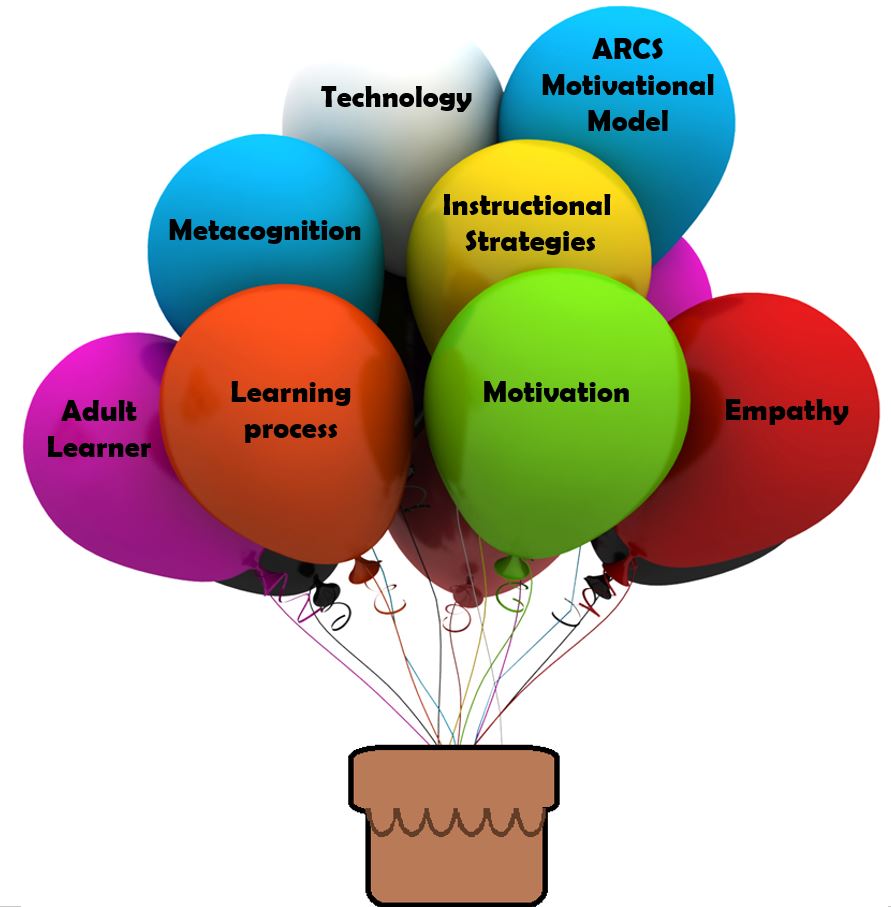Motivation in eLearning – Understanding the Adult Learner

In the previous post, “ARCS Model and Instructional Design – Motivation in eLearning” we discussed different strategies about how to keep our learners motivated through course design. In this post, we will continue exploring this fascinating topic of motivation in eLearning and we will explore other strategies to motivate our learners including more cognitive elements related to motivation and learning.

Motivational Factors in the Online Classroom – Extrinsic and Intrinsic Factors
Some of the extrinsic factors that motivate learners in an online classroom are behaviours of instructor, learning topics, instructional strategies, teaching-learning process, interaction between the learners and the instructors, the technology used and the rewards or goals to be achieved upon completion of the online course (Selvi, 2010).
On the other hand, the intrinsic factors that motivate learners are the perception of competence, adequate stimulation or challenges, positive feedback, self-determination or the power of selecting and having autonomy, relatedness or having involvement and interpersonal connections, and social engagement among others (Shroff & Vogel, 2009).
Addressing Keller’s ARCS Motivational Model
To incorporate these factors in an online classroom it is important to plan the instructional experience addressing the four areas of Keller’s ARCS model (ARCS Model, n.d.) as detailed below:
Attention: To capture learner’s attention in an online classroom I would encourage active participation in order to get learners  involvement in the content and activities of the course. To achieve this, I would design and incorporate activities such as:
involvement in the content and activities of the course. To achieve this, I would design and incorporate activities such as:
- Present a real world challenge or situation to increase curiosity and stimulate interest in the topic.
- Raise questions and promote learners to raise questions and participate in discussions to create an environment where learners can connect with their peers and get involved in the learning process. This strategy also helps to stimulate curiosity and increase learner’s attention.
- Use a variety of methods to present content in order to offer options for learners to choose from when learning the topic. This increases exploration and interest in the topic and also helps in the reinforcement learning process. By doing this, learners will elaborate knowledge using variety of methods that will facilitate recall in future uses of this knowledge.
Relevance: It is important that the learners know why they have to do the online course and why it is relevant for the achievement of their goals. Some of the strategies I would include to establish relevance are:
their goals. Some of the strategies I would include to establish relevance are:
- Present practical situations or uses of the topic to clarify usefulness of the content.
- Create activities where the learner has to use previous knowledge or experience to build new concepts. Some of these activities could be writing about how previous experiences relate to new content or discussion forums to share learners’ experiences.
- Present videos, interviews, or a multimedia presentations from experts in the area to have variety in the content and to show experts in that particular field that could inspire and serve as models for the learners.
Confidence: I would encourage in the online classroom a positive language to help learners understand they can succeed in the course. The online course should also include achievable challenges that will boost motivation. If some of the tasks have some level of complexity, I would add clues or hints that would give the learner a sense of competence, a sense of mastery.
course. The online course should also include achievable challenges that will boost motivation. If some of the tasks have some level of complexity, I would add clues or hints that would give the learner a sense of competence, a sense of mastery.
Some of the strategies I would include are:
- Provide clear learning objectives and prerequisites.
- Start with simple and basic ideas and increase complexity in small steps.
- Split course in small sections, units or modules to increase opportunities for succeed.
- Give learners some control over their own learning by providing options. For instance, in a particular assignment or project I would provide freedom to choose the tools to present the project (audio visual, web design, blog, slide show, YouTube video, etc.).
Satisfaction: To increase satisfaction I would provide positive feedback, score assessments with comments highlighting the best part of the task developed by the learner. Other strategies I would include are:
of the task developed by the learner. Other strategies I would include are:
- Badges or virtual rewards in the online classroom.
- Activities where the learner has to put in practice new skills or knowledge. These activities could be adding a new entry in a virtual portfolio, or blogging about the new knowledge.
Instructional Strategies
These are strategies that can positively influence students’ achievement emotions and subsequent motivation, learning and performance:
| Category | Definition | Instructional Strategies |
| Cognitive Quality |
The structure and clarity of instructional activities and their potential for cognitive stimulation. | Clearly structure activities.
Ensure task demands match students’ capabilities. |
| Value | The importance, use, and value of instructional activities. | Explicitly link basic science content to its clinical relevance.
Utilize authentic learning activities that do not overwhelm students’ working memory capacity. |
| Control and Confidence | Students’ personal control over and confidence in successfully completing instructional activities. | Help students identify and set challenging, proximal goals.
Provide students with timely, honest, and explicit feedback. |
| Autonomy Support |
The extent to which instructional activities support student independence and self-regulation. | Provide students with choice of instructional activities.
Seek to understand what motivates students and nurture those inner motivational resources. Use non-controlling language in the classroom and clinic. Provide explanatory rationales to reveal why certain course activities or student behaviours are truly worth the effort. Display patience and allow time for self-paced learning to occur. Acknowledge, accept, and even welcome students’ expressions of negative affect as it relates to tasks that may, in fact, be boring or difficult. |
| Goal Structures |
The extent to which school environments, classroom structures, and teacher behaviours encourage mastery-oriented goals. | Ask students to engage in personally meaningful and challenging tasks with flexible participation structures.
Give students the opportunity to participate in creating the rules and regulations that affect their academic activities. Recognize and value mastery-goal ideals, such as effort, risk taking, and creativity. Group students based on shared interests and for the purposes of facilitating learning and interaction. Assess students formatively using grading policies and feedback procedures that evaluate progress and promote mastery of essential knowledge and skills. |
Motivation and Cognition
The motivation of your learners is an important factor that will impact the overall effectiveness of the learning experience.
To learn effectively, learners have to want to learn the content of the course. And that’s where motivation comes into the picture.
There are so many strategies we can use to motivate students to learn. Lots of these strategies are based on cognition processes.
For example, the cognitive component of interest. Is something interesting? Some people will find certain topics interesting, while others won’t have an interest at all.
But there are ways to evoke interest, such as presenting something that’s different, that’s not what you would expect, a challenging situation.
The Adult Learner and Motivation
Adult learners have an advantage over the more traditional college student in the sense that, in most cases, adult learners have a strong need to know. Adult learners know the implications in engaging in professional development experiences or courses for career advancement or simply as part of a life-ling learning situation.
If they have a defined interest, they will want to do the course, be there, engage and they will be motivated.
Adult learners have some psychological needs that have implications for motivation. Some of these needs are:
- Arousal or stimulation: people have a need for mental stimulation. And one of the things we can do in instruction is to make sure that need for arousal is met, some cognitive stimulation is needed to keep it going. Challenging situations, enigmas, secrets, clues, puzzles, shocking facts are ways to promote mental stimulation.
- Competence: a need to feel that you’ve done something well, which means that you need to have a learning environment where you’re succeeding most of the time. You can still include challenges in the training, but they need to be achievable to make learners feel good about themselves.
- Autonomy or self-determination: we need to have some sense that we are controlling things to some extent. Give your learners choices in different situations so they can pick how to navigate your training, how to be assessed. Branching scenarios, free navigations, alternatives, choices. All these simple strategies help learner have a sense of autonomy and self-determination, which will contribute to maintaining motivation.
- Relatedness: as human beings, we historically have had needs to interact with others. We see this in the educational environment in our need to have a good relationship with our instructors and peers. We like to know that there is a sense of relatedness that we are in this together in some way. This is challenging in the online environment, but it still can be achieved with social learning, collaboration, forums and chats.
In a face-to-face course, there are lots of ways to promote relatedness, by conveying our own enthusiasm about a topic, getting learners physically involved in hands-on activities, smiles and a positive attitude can motivate learners.
What other strategies can I implement? 
These are many ways to motivate learners in the eLearning space. Some strategies you can use are:
- Simulation: simulate a particular situation. Learners have to interact with the simulation in some way that it resembles a real-world task that gets them engaged not exactly in a hands-on way but in a virtual hands-on way, and they get immediate feedback. Scenarios are an example of real-world simulations.
- Problem solving: one thing that can be highly motivating in eLearning is a problem to solve. Present a problem with a series of hints, create a challenge. Present a question with possible options, if learners still have trouble finding the solution then offer more alternatives and hints. This activity will be part of a scaffolding learning process, where learners will interact with the problem until they can solve it correctly. For this activity to be motivating it has to be intriguing, challenging and still solvable to avoid frustrations. When learners fix the problem, give them an award, give them a sense of competence, a sense of mastery.
- Elaboration: take new information and do something mentally with it. This is a very constructive kind of process. For example, you can incorporate a new idea and then prompt questions so learner start thinking about it. Learners will draw inferences from it, think of new examples. Encourage learners apply the new concepts into their real world or work practice. Applications, questions and examples are good ways to promote elaboration.
- Comprehension Monitoring: include knowledge check points in your courses to get your learner think about their learning. So the key is to periodically stop, check and provide feedback or corrective actions.
- Mnemonics: if you want your learners to remember some sort of sequence, procedures or steps, then use mnemonics so they can remember with a key word what is involved in that process. Also, present mnemonics in an interactive an attractive way that more visual learners will remember.
In Summary
As you can see there are many ways to motivate our learners. Luckily we have many strategies and artifacts we can include in our courses to help students get engaged and more motivated.
If you have implemented as many design strategies as possible and still your learners are not responding as you would expect, you can try to empathize so you will know where they are coming from and what the problem is. Try to establish a connection with the learner, even in the online environment it is possible through emails, chats and forums.
Other way to establish that connection with your learner is by creating an activity to grab their attention, similar to the icebreaker activities we discussed in the post “Icebreaker Activities in Online Classes”. You could also introduce the new topics by given your learners a taste for the topic in an intriguing way, perhaps by sharing how you used that particular knowledge in a real situation.
Once you have that empathy with your learners and even a small connection they will be more interested in what you have to say and share and they will respond and get more motivated.
I hope you found this information useful. How would you like to motivate your learners?
Leave your comments below.
See you next time.
Thais 😀

References
ARCS Model. (n.d.). What are the ARCS categories?. Retrieved form http://www.arcsmodel.com/#!arcs-categories/c1zqp
Artino, A. R., Holmboe, E., & Durning, S. J. (2012). Control-value theory: Using achievement emotions to improve understanding of motivation, learning, and performance in medical education. Medical Teacher, 34, e148-e160.
EduTech Wiki. (2013). ARCS [Wiki post]. Retrieved from http://edutechwiki.unige.ch/en/ARCS
Laureate Education (Producer). (n.d.). Motivation in learning. Retrieved from https://class.waldenu.edu
Learning-Theories.com. (n.d.). ARCS model of motivational design (Keller). Retrieved from http://www.learning-theories.com/kellers-arcs-model-of-motivational-design.html
Selvi, K. (2010). Motivating factors in online courses. Retrieved from http://www.anitacrawley.net/Articles/SelviMotivating%20Factors.pdf
Shroff, R. & Vogel, D. (2009). Assessing the factors deemed to support individual student intrinsic motivation in technology supported online and face-to-face discussions. Journal of Information

4 Responses
This is brilliant and so relevant – I’m doing a post-grad certificate in education and we are always taught that adult learners will not engage if they aren’t motivated or can’t perceive the relevance to them. Do you think it’s harder to engage and motivate learners when teaching online rather than face to face? What strategies do you use to overcome this?
Hi Amy, motivating learners online is definitely a challenge and I found it even harder compared to face to face sessions. But there are many strategies to engage the learners and motivate them, such as using ice breaking activities to connect with the students, adding interactions like games, badges, rewards. With adults is also necessary to let them know what’s in the training for them, what is the benefit. If they have that clear, they’llbe most likely engaged.
Hi, I like this information, I think it can be applied to even toddler. Finding something that peaks their interest or that will motivate them to want to pay attention or learn could prove to valuable info for moms. I know with my son, I find he pays attention to me more when I have something he is interested in. I think you have a great post here with lots of valuable information and you have really explained everything in-depth. Thanks for sharing.
Thanks Jen. I experience the same with my son. When I want to get his attention I talk about a car or a dinosaur or try to connect with something he’s tuned in at that moment.